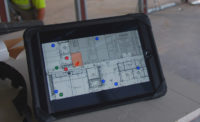The drive to create “digital twins” of physical facilities is transiting from idea to reality, as sophisticated owners and their construction management consultants begin harnessing the growing power of computer processing, reality capture and improved data management tools and techniques to begin putting digital meat on the twins’ bones.
One of the latest examples is a growing digital twin of the New York City Metropolitan Transit Authority’s $10-billion East Side Access project. The ESA’s cavernous, almost nine-block-long concourse has become a testbed for the technology, which has, in turn, led to further developments of the tools and their use on other projects.
LiRo Group “is taking the digital twin into operations,” says Lennart Andersson, director of VDC and senior associate vice president at the New York-based construction management, engineering, environmental, architectural and program management firm. “We’re making sure the contractors are populating the BIM with the data.”
In its role as construction manager, LiRo has been collecting scans and spatial data on the ESA concourse since May 2017 and developing tools, simplified tagging schemes and nomenclature to relate the real-world metadata about asset objects to their digital counterparts in the BIM. It is changing a 3D geometric model into a database of the actual facility—a digital twin—in the process. “BIM is a spatial database, but few use it like that,” says Andersson. “Generally, this industry is not looking at that concept. BIM is being used to visualize. We’re using it as data.”
LiRo’s Virtual Design, Construction, & Operations Services group created Form D, an app for data collection, which is about to be released for public use. John B. McCaffrey, CIO, says the group has added “Operations” to the VDC unit in recognition that the digital twin is there to serve the full building lifecycle. “That’s what it is all about: the building being up and running,” he says.
In a preview of Form D at the company’s new VDCO lab in lower Manhattan on March 14, Andersson demonstrated how the app initially was developed for inputting field confirmation about structural object status and feeding it into the BIM. Andersson says Form D can be used to feed object data into any facility or infrastructure BIM, although it is optimized for use within the BIM and construction management practice LiRo offers as a service to owners.
In a view of the ESA BIM, the status updates can be visualized by color-coded representations of elements, but more significantly, the status data can become part of the owner’s operating platform for all business systems, processes and purposes involved with the project, including accounts payable.
Andersson says the VDCO group’s impending introduction of Form D will include a new feature designed to support bridge inspectors. The group has taken scans of New York’s Marine Parkway Bridge and developed a process to generate a clean model of the bridge from the scans. It will then generate 2D drawings from the model with all of the bridge elements automatically tagged to match the FHA’s National Bridge Inspection Standards and facilitate tablet use of Form D for inspection recording and capture of findings, back in the digital twin.
“It’s a tremendous problem, inspecting bridges,” Andersson says. “The app development was driven by the needs of the inspectors. They had the problem and we have created a solution.”




Post a comment to this article
Report Abusive Comment